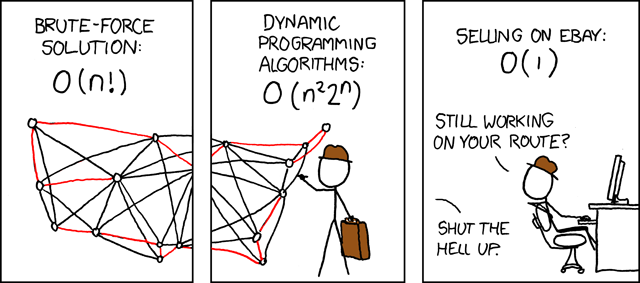 |
| To the A.I., a simple game of poker is a tree of all possible events. Image from Heads-up Limit Hold’em Poker is Solved by Michael Bowling, Neil Burch, Michael Johanson, and Oskari Tammelin. |
A solution concept for a game like poker is called the Nash equilibrium. The definition is simple, for non-cooperative games, the strategy each player has chosen to play the game is the best strategy they can employ assuming they know the strategies of others. Players will receive no benefit from changing their strategies as the strategy they already chosen is the best strategy for them. Finding the Nash equilibrium, the best possible way of playing the game, using linear programming takes an exponential amount of time, O(2nk). This is a simpler time complexity than brute forcing a traveling salesman problem (TSP) but still takes an incredible amount of time because it's not polynomial. However, finding the Nash equilibrium does not fall under NP-complete. Nash's theorem concludes that a solution is guaranteed to exist, while it's unclear whether NP-complete problems can have a polynomial solution at all. So instead of being grouped under NP-complete, Nash equilibrium falls under another subclass of NP call PPAD, where solving the problem may be difficult but the solution is guaranteed to exist. This applies for finding the Nash equilibrium on non-cooperative games with k-players, provided k is a finite integer greater or equal to two.
 |
| An A.I. plays the game of love. Image courtesy of https://xkcd.com/601/. |
Edit: I mistook exponential as factorial and it has been corrected.
References
The official website for Brains vs Artificial Intelligence
Bowling, M., Burch, N., Johanson, M., & Tammelin, O. (2015). Heads-up limit hold'em poker is solved. Science, 347(6218), 145-149. doi:http://dx.doi.org/10.1126/science.1259433
Daskalakis, C., Goldberg, P. W., & Papadimitriou, C. H. (2009). The complexity of computing a nash equilibrium. Association for Computing Machinery.Communications of the ACM, 52(2), 89. Retrieved from http://search.proquest.com/docview/237061886?accountid=14541
Fortnow, L. (2005, December 15). Computational Complexity. Retrieved April 26, 2015, from http://blog.computationalcomplexity.org/2005/12/what-is-ppad.html
Osborne, M., & Rubinstein, A. (1994). A course in game theory. Cambridge, Mass.: MIT Press.
Rubin, J., & Watson, I. (2011). Computer poker: A review. Artificial Intelligence, 175(5-6), 958-987. doi:http://dx.doi.org/10.1016/j.artint.2010.12.005
Sandholm, T. (2010). The state of solving large incomplete-information games, and application to poker. AI Magazine, 31(4), 13-32. Retrieved from http://search.proquest.com/docview/847665029?accountid=14541
von Stengel, B. (2010). Computation of nash equilibria in finite games: Introduction to the symposium. Economic Theory, 42(1), 1-7. doi:http://dx.doi.org/10.1007/s00199-009-0452-2
